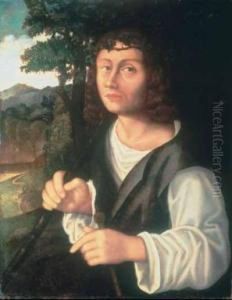Francesco Torbido Paintings
Francesco Torbido, also known as Il Moro, was an Italian painter of the Renaissance period, born around 1482 in Verona. Little is known about his early life, but it is presumed that he initially trained with local artists in Verona before moving to Venice to study under the Venetian master, Giovanni Bellini. This training was crucial in shaping Torbido's style, as Bellini was one of the most influential artists of his time, known for his rich color palette and sensitive approach to light and shade, elements that would become characteristic in Torbido's own work.
After his apprenticeship, Torbido returned to Verona, where he became a prominent painter. His works largely reflect the transition between the late Gothic and Renaissance styles, and he is known for integrating the Venetian colorism learned from Bellini with the more traditional Veronese style. He painted many religious subjects, which was typical for the period, including altarpieces and frescoes for churches. His work was also influenced by other contemporary artists such as Albrecht Dürer, whose prints were widely disseminated and admired at the time.
Throughout his career, Torbido maintained a close connection with the artistic developments in Venice, which was one of the leading art centers of Italy. This connection greatly impacted his work, allowing him to incorporate the latest Renaissance ideas into his paintings. However, Torbido's style also included a certain emotional intensity, perhaps a reflection of the turbulent times he lived in, marked by wars and political strife in Italy.
Torbido's most notable works include frescoes in the Cathedral of Verona and the Church of San Bernardino in Verona. His portraits are also highly regarded, characterized by their psychological depth and nuanced depiction of the sitters. Unfortunately, many of his works have been lost or damaged over time, which makes a comprehensive assessment of his oeuvre challenging.
Francesco Torbido's exact date of death is not well documented, but it is believed that he died around 1562. Despite not being as widely known as some of his contemporaries, Torbido made significant contributions to the art of the Italian Renaissance, particularly in Verona where his influence was felt by succeeding generations of artists.
